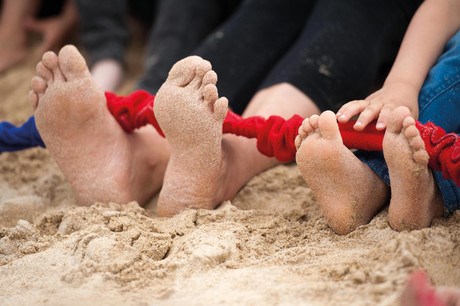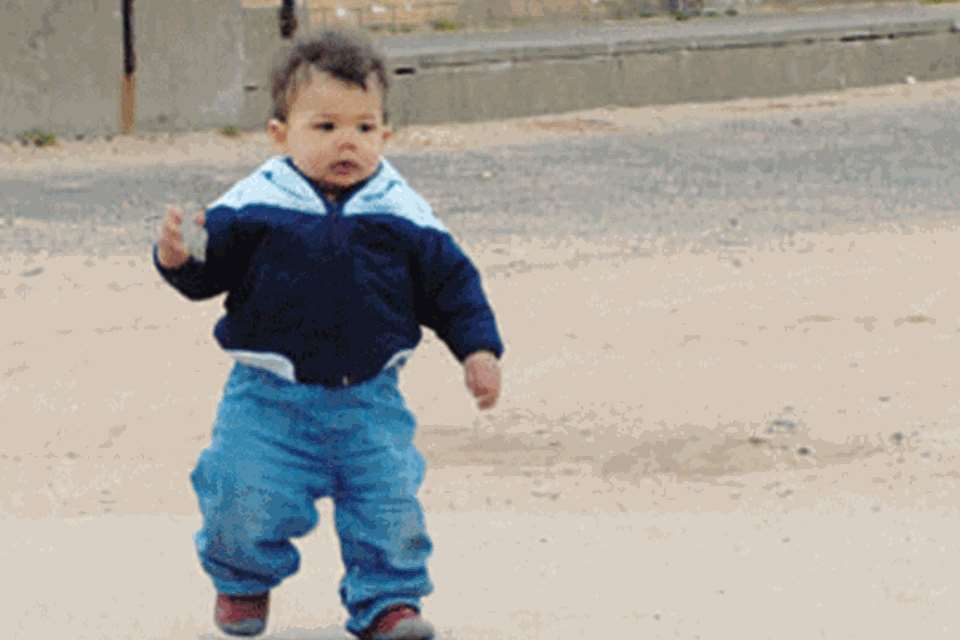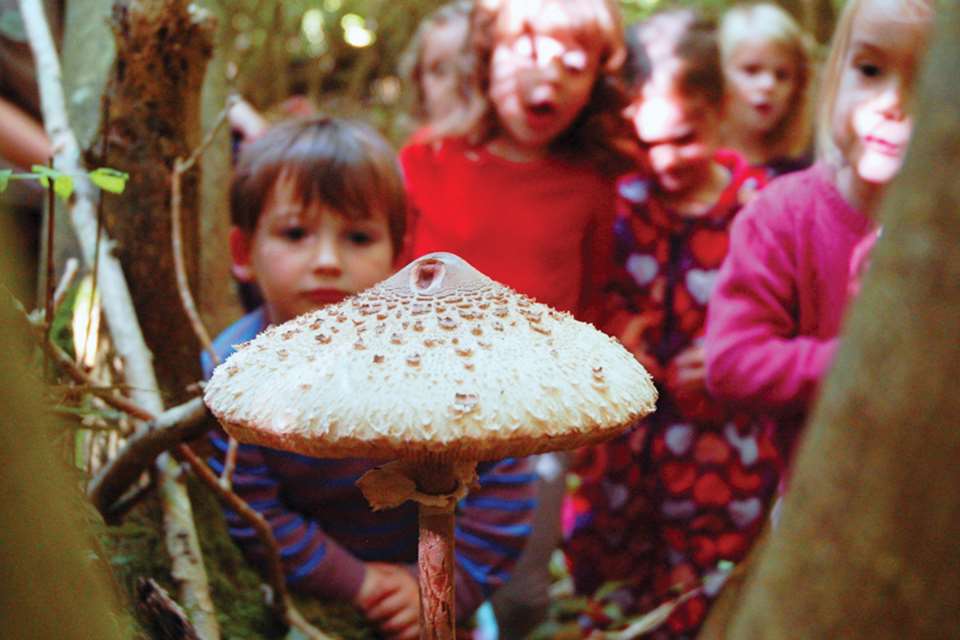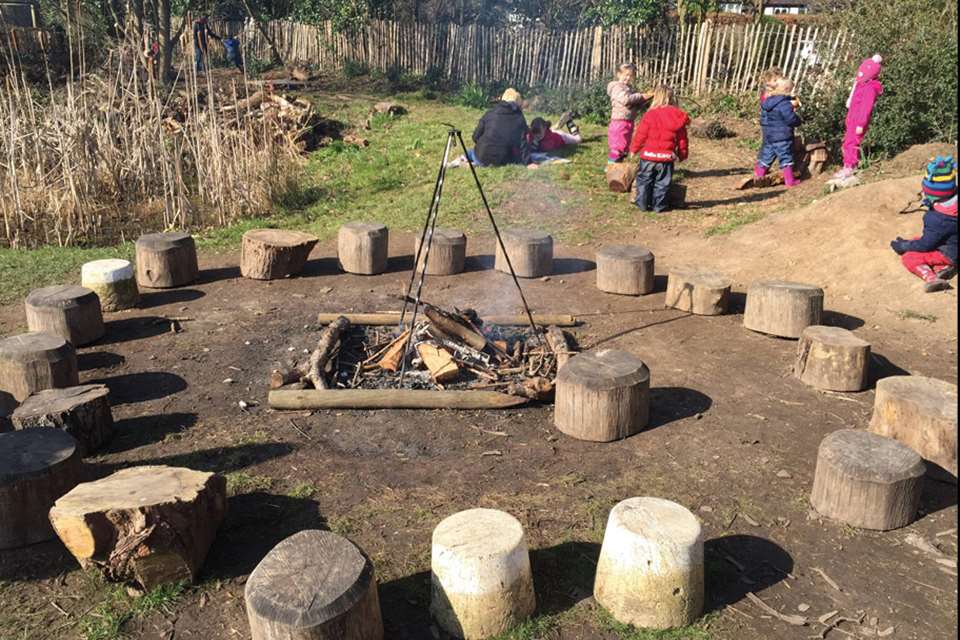EYFS Best Practice - All about…beach schools
Nicole Weinstein
Monday, July 11, 2016
Four beach schools (and one river school) tell Nicole Weinstein about their exciting activities
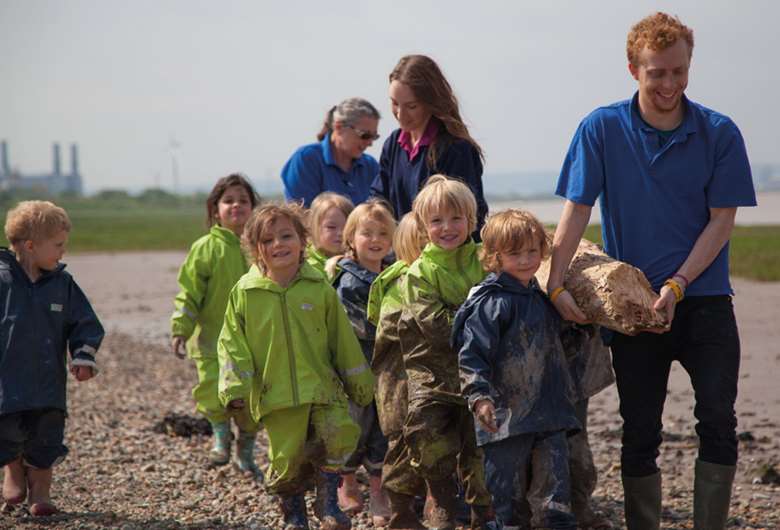
A visit to the beach with breaking waves in the foreground can be an awe-inspiring experience. For a child, the beach is a giant playground, a natural canvas where they can explore hidden nooks and crannies, search for treasure, roll down sand dunes, fish in rock pools, dig in the sand, listen to the sound of the waves, feel the salt water on their skin… the opportunities are endless.
Juliet Robertson, of Aberdeenshire-based Creative STAR Learning, says, ‘Simon Nicholson’s Theory of Loose Parts talks about “variables” in an environment, which are the loose materials and include the water, sand, tides, rocks, shells, plants, animals, sounds and smells. At a beach, the interplay between all these elements provides limitless opportunities for children to engage in all different types of play at a highly multi-sensory level.’
Many settings that are based near the coastline, or a river, are now making use of this natural space as part of their outdoor learning offering, with many forest school leaders adopting the same approach on the beach as they do in their woodland sessions.
Jon Cree, chair of the Forest School Association, says, ‘The forest school pedagogy can be adapted to suit any habitat: it’s regular learner-centred sessions that build a relationship with the place. What makes the seashore or beach distinct from forest school is the opportunities offered by the place.
‘There is much play-based learning offered by the beach, from experimenting with rocks and pebbles through to play on the sand and investigating rock pools. There’s also lots of creative possibilities from sand art through to storytelling and sit-and-spot experiences.
‘The life found on the beach is rich and required to live in quite hostile, changeable conditions. And the beach is an ever-changing place, unlike the slower changes you can witness in the woodland. The tides and terrain also present children with new challenges in risk-taking,’ he adds – from recognising the tides and flows of water through to rock clambering to get to rock pools and the direct sunlight in the summer.
When taking children to the beach, Ms Robertson advocates focusing on the ‘core elements’ – air, water, earth, fire, plants, animals – and processes – life cycles, energy transfer, reusing and recycling (waste) – so that children can make connections in their learning and come to understand how we look after ourselves, each other and any place where we play. She says, ‘It’s about the joy of being outside and exploring the special qualities of any natural space.’
CASE STUDIES
CAMBORNE NURSERY SCHOOL, CORNWALL
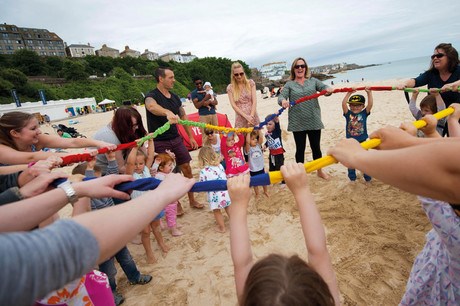
Beach: Portreath, 5km miles from the nursery by minibus
When it started: 2013
Number of children: 128-place nursery; 40 three- and four-year-olds visit the beach twice a term and the nursery holds an annual family day
Ratios: 1:3 with qualified teachers, 1:2 with teaching assistants
‘Taking children to the beach is an extension of our “outdoor school”, which includes time spent in our orchard, our garden and our local woods at Tehidy,’ explains assistant head teacher Carrie Richards. ‘And our practitioners are experienced and confident with all aspects of the outdoors – after lots of in-house training sessions.’
The beach school follows a similar structure to other outdoor sessions. To start, the children sit in a circle, sing a ‘hello’ song and are asked questions to encourage them to use their senses – listening or looking for a particular sound or object. Hot chocolate and a biscuit round off the day.
The activities themselves depend on the weather and the tide, explains Ms Richards. ‘We may provide the children with paper and pens and ask them to do a treasure hunt where they find interesting objects, pebbles, seaweed and shells.
‘If we explore the rock pools, we might link it to prior learning. For example, we have read the book Sharing a Shell by Julia Donaldson so we will ask the children, “What can you see in the rock pool?”, “What might be under there?”, “If you were a barnacle – what might it feel like to live in there”, “How big are they compared to us?”
‘Sometimes we may “borrow” resources from the beach and take them back to the nursery to explore in the Tuff Spots. We make it our policy to always return items to the beach.’
On one occasion, the children found a dead fish, which was taken back to the nursery and dissected so the children could see what was inside. Staff then bought a couple of fish; a trout which they cooked and ate together with the children, and another which was left out so the children could touch the skin and do observational drawings of it.
On another visit, the children found a green bottle covered in barnacles, which they took back to the nursery to investigate before returning it to the beach.
‘Taking children to a beach like this – a beach that has a river that flows through it and has rock pools and cliffs and a rough sea – is a real-life experience that captures their imaginations and curiosity and encourages them to investigate their surroundings,’ says Ms Richards. ‘In the winter, we do a risk assessment and we watch the height of the waves crashing around the pier.
‘These experiences are particularly important because some of our children have never been in the sea – or even to the beach. During our family day at Porthminster beach in St Ives, we support the whole family to have the confidence to get over their childhood fears and have a paddle. It is great to see the whole family enjoying this free resource that is on their doorsteps.’
www.camborne-nursery.cornwall.sch.uk
WILDBEACH, ISLE OF WIGHT
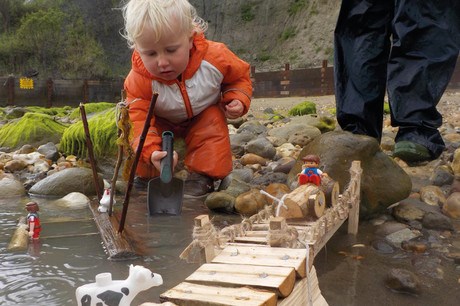
Beach: East Wight Coastline
The Wildbeach project takes the Forest School principles of child-centred learning in a natural environment from the woods to the coast. The aim of the project is to connect children with nature, particularly the coastal environment of the East Wight.
Kathy Grogan, education officer for Hampshire and Isle of Wight Wildlife Trust, is delivering the project with Wildbeach officer Ric Temple. She says, ‘Many people find it surprising that even children who live in coastal towns do not necessarily visit the beach, so we want to put them in touch with their natural heritage and reap the benefits to their learning and development, as well as give them a sense of place and of guardianship of their local environment.’
Part of the Down to the Beach initiative, funded by the Heritage Lottery Fund, the Wildbeach Project is now well under way, with family events in the school holidays and Wildbeach Wednesdays, a programme of seashore sessions at Shanklin beach, with sessions for toddlers in the mornings and home-educated children in the afternoons. Local schools are also involved, with St Mary’s Catholic Primary School in Ryde currently using their local beach for a six-week programme.
Ms Grogan says, ‘The children use the natural environment to learn through play and exploration of the habitat, and activities are inspired by the children. We have a mobile sand kitchen, and we use the natural small parts and materials we find on the beach, such as sand, shells, stones, clay, seaweed and the rocky shore habitats, as well as the weather, the season and the children’s own interests to dictate the activities we do.
‘During a recent toddler session, we introduced the children to small-world play by providing them with small wooden bridges that they could use over the sand and water. We also built boats out of cuttlefish bones and gull feathers, as well as bark and willow we brought with us from the forest. The children in the home school sessions built stone harbours and raced the boats.
‘There’s also a lot of free play that takes place. We provide buckets and big plastic scoops and spades. Some children like to do large-scale excavations in the sand, others like to paddle in the sea. This week the toddlers started off in wellies and waterproofs and ended up having a paddle.’
ST THOMAS NURSERY, LYTHAM, LANCASHIRE
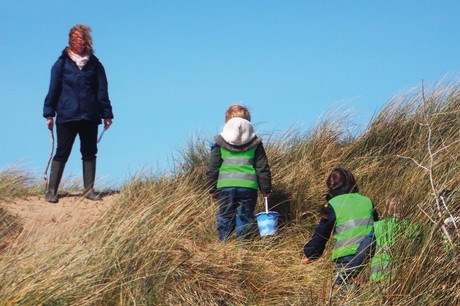
Beach: St Anne’s, a 15-minute walk from the setting
When it started: April 2016
Number of children: 40 places
Ratio: 1:2 on the beach and the setting aims to take ten children once a week
St Anne’s beach, on the Ribble estuary, is flat with soft sand and dunes, which the children love to run and roll down. In its 16-year history, the nursery has accessed the beach periodically, but now that supervisor Anne Swindlehurst has completed her Level 3 Beach School qualification, the aim is to take the children there once a week and involve them in more adventurous activities.
‘The beach is perfect for our four- and five-year-olds,’ she says. ‘I did the course simply to cover the safety aspects of taking children onto the beach, but we do want to branch out and begin to light fires and cook food with the children on the beach. We are using the beach as an extension of the nursery environment.
‘On our first visit, the children, who walk to the beach in groups of ten, focused on the journey itself. We orientated ourselves – we took photographic evidence of the signs that we saw on the way and two churches that we passed to get to the beach. When we arrived on the beach, we did some general beachcombing, looking for litter and hazardous items. We have also investigated the salt marsh pools and made shapes with sticks and other natural materials.
‘We use Field Studies Council guides, which are laminated fold-out sheets, to look up and reference the creatures and plants that we find on the salt marshes. We also identify the birds and we try to work out what the different tracks are in the sand. They might be tracks made by the yachts or the large Caterpillar trucks that clean up the beach. We take lots of photos of our findings and we reference them back at the nursery.
‘One week we focused on letters and sounds and we decorated the beach with natural tools for mark-making – feathers and twigs – and the adults wrote the children’s initials in the sand. When the children found their initials they decorated them with shells, seaweed and stones.
‘During the next session the children made their own marks in the sand. All of these activities support and promote language acquisition. We also use beach materials to make big art projects on the beach as well as using the resources that we collect and take back to nursery for small art projects such as mobiles and collages.
‘Taking the children down onto the beach to run down the sand dunes has also helped enormously with their physical development skills. We are an all-weather nursery with an extensive outdoor environment, but risky play really comes into its own in this environment because children are free to get a bit wet and sandy as they tumble down the dunes. It’s a pleasure to watch.
‘We also find that many local children don’t access the beach, apart from to walk the dog, so we are engaging the families by getting together with the beach patrollers to do two-minute beach sweeps.’
http://st-thomas-nursery.co.uk
WOODLAND HOUSE NURSERY, WEST BRISTOL
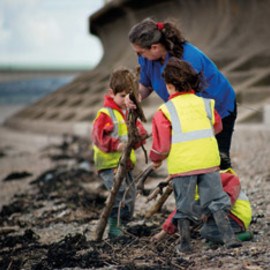
Beach: Severn beach, a 20-minute train journey away
When it started: on International Mud Day, June 2012
Number of children: 50-place nursery; up to 20 three-and four-year-olds visit the beach once a week
Ratio: 1:4
Stones, mud and shingle, rather than golden sand, are the main features of the Severn beach, but it ‘still provides a great learning environment’, says nursery manager Emma Base.
‘Sometimes the tide is in, sometimes it’s out, and there is always lots to explore. There’s a grassy bank on one side, which the children can use if the tide is out and it’s really muddy. Here, they can pick the daisies and listen to all the sounds and smells of the sea. But generally the children love to explore the sticky mud – and when we’re there, they are free to explore in whatever way they choose.’
Staff, including a beach school Level 3 leader, carry rucksacks containing buckets, spades, magnifying glasses, notepads, pencils and clipboards. And children are kitted out in all-in-one waterproofs and wellies, whatever the weather.
Sometimes the children just want to dig holes or use their imagination to create small worlds with the pebbles or driftwood found on the beach. Some like to use sticks and stones to write and make patterns in the sand. If the tide is in, they like to throw pebbles in the water.
‘There are so many surfaces to explore – stone, rock and crunchy seaweed,’ explains Ms Base. ‘We’ve found live crabs and an eel in the rock pools and we often bring back lots of resources from the beach and incorporate it into the children’s learning and their artwork.
‘We always start with a risk assessment. The children sit in a circle and we talk through the boundaries, pointing out the area where we will be based for the two-hour session, and the areas that they shouldn’t go beyond. We remind them that if they see glass, they should tell an adult, or if a dog runs up to them they should stay still. We encourage them to take risks by lifting big rocks into the mud and helping to gather driftwood and branches to build the camp fire. It’s a wonderful learning environment.’
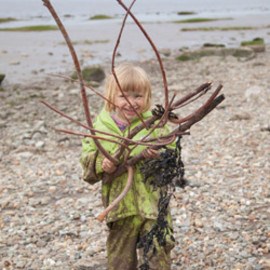 Sister setting Archfield House Nursery set up its beach school just three months ago. Christine James is a qualified beach school leader for both settings, so Archfield has been able to take advantage of the procedures and routines that Woodlands has designed and perfected over the past four years. Now plans are afoot to share that expertise further afield.
Sister setting Archfield House Nursery set up its beach school just three months ago. Christine James is a qualified beach school leader for both settings, so Archfield has been able to take advantage of the procedures and routines that Woodlands has designed and perfected over the past four years. Now plans are afoot to share that expertise further afield.
Cassie Holland, beach school co-ordinator for both settings, will be working with nursery director Rebecca Clevett to set up Bristol Beach School and share practice with other families, nurseries and schools and the local community.
Everyone at Archfield is already a fan of beach school. ‘You don’t need to speak about beach school for long to see the pure joy it brings our children,’ says Ms Holland.
‘Our parents are complete advocates and we are currently trying to rotate staff so that they get experience of beach school even if they are not based with our pre-schoolers as it is so popular.’
www.woodlandhousenursery.co.uk
www.archfieldhousenursery.co.uk
STRAMASH FORT WILLIAM NURSERY, WEST SCOTLAND
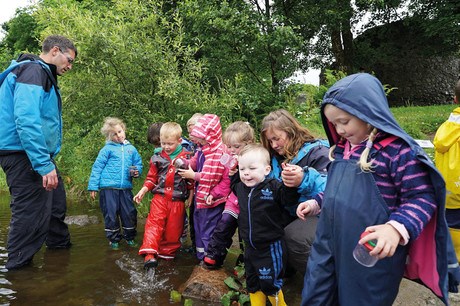
River: River Lochy, 30 seconds away
When it started: April 2014
Number of children: 32-place nursery; all two- to five-year-olds access the river up to five days a week
Ratio: 1:5
Surrounding Old Inverlochy Castle on the west coast of Scotland is the River Lochy, which Stramash Fort William outdoor nursery is lucky enough to have on its doorstep. ‘Some weeks we are out on the river bank all day, every day; others we access it for part of our learning or just to eat snacks and look at the magnificent view,’ explains Cameron Sprague, early years and family team leader.
‘Children have recently been interested in transport, so we’ve spent a lot of time on the river watching the trains cross over the bridge. We’ve also made small boats that float down the river – and the children have even had a go at canoeing.
‘We want the children to be confident on the water and one way to do this is to give them real-life experience of it. We talk about how the weather affects the water. If it rains a lot, they can see for themselves the water rising up to the castle wall.
‘They also begin to understand that if the weather is bad, the water can be dangerous, as they’ve seen whole trees floating down the river during storms. At the moment, it’s calm and they enjoy splashing around in it, and when the tide is low, they love to hunt for creatures in the rock pools.
‘There’s a lot of wildlife to explore – we’ve seen seals passing through and we look up the names of birds in our nature detective sheets, which is good for their literacy skills. There are a lot of different surfaces to explore on the river bank. The area that’s closest to us is rocky with a steep bank. The walk to the castle has a jagged bank and at the foot of the castle there’s a grassy river bank with sand.
‘The entire river bank is an extension of our site. We care for it by picking up the litter, we eat our snacks on it and we love to scramble on the rocks. The children love to go geocaching along the river, which is great for developing their ICT skills. People have hidden treasures all along the banks and we often go out using GPS to find the boxes.
‘It’s a magical place to be – whether children are climbing the banks to get to the ruined castle to play hide-and-seek in the turrets, skimming stones or listening to the water as they eat their snack on the grassy bank.’
HOW TO BE SAFE ON THE BEACH
By Kathryn Grogan, education officer for Hampshire and Isle of Wight Wildlife Trust (HIWWT)
Early years settings are used to carrying out risk assessments before outings, but when it comes to choosing a coastal location, it is vital to think very carefully about whether or not it is appropriate for a visit. So get to know your site well, record associated hazards in your risk assessment and, ideally, visit the beach at different states of the tide before you head off.
Risk assessment
Questions that you might want to ask yourself include:
Is there a lot of rubbish on the beach?
Does the tide sweep in fast? Are there strong rip tides?
What is the geology of the area? Is there soft sand or mud, slippery or sharp rocks?
Are oil, chemicals or sewerage washed in or flushed out from the beach?
Are any cliffs above the beach safe?
Is the beach busy with members of the public?
Are there uncontrolled dogs and dog mess?
How remote is the site? Do you have mobile phone signal and easy access to a road in case of emergency?
NB This should not be seen as a comprehensive list of things to look out for.
Time and tides
Make sure you know how to read a tide table and be particularly aware of:
the effect that offshore winds can have on the height of the tide. You may need to reschedule your visit in the event of blustery winds
when the tide is turning as the water can be turbulent
any marine fauna that could cause harm, and know what to do in the event of anyone being stung.
It is a good idea to set a boundary for the spot you want to visit, and then do a two-minute clean-up of the area to ensure there are no sharp objects, dog mess or litter.
We run coastal sessions between April and November and keep a close watch on weather forecasts.
Must-haves
? A throw-line – and know how to use it ? first aid kit – and trained first-aider ? plastic bags and sharps box for litter, dog mess, etc ? warm blanket
CPD training
For water safety training, visit: www.rlss.org.uk. Non-accredited CPD training in coastal education is available from HIWWT (www.hiwwt.org.uk) and Sussex Wildlife Trust (https://sussexwildlifetrust.org.uk). Bespoke courses can be arranged with Richard Irvine Outdoor (http://richardirvine.co.uk) and Niki Willows Outside (www.facebook.com/Niki-Willows-Outside-300653194725).
To book HIWWT beach sessions, contact Jess.Daish-Millar@hiwwt.org.uk for Hampshire, and Richard.Temple@hiwwt.org.uk for the Isle of Wight
MORE INFORMATION
http://creativestarlearning.co.uk/contact
www.archimedes-training.co.uk/our-training/beach-schools
http://kindlingplayandtraining.co.uk/learn-outdoors/beach-school
North Yorkshire Outdoor Learning Service, www.outdoored.co.uk/content/uploads/2014/12/Forest_School_Flyer2015.pdf
http://forestandbeach.co.uk/education.htm
